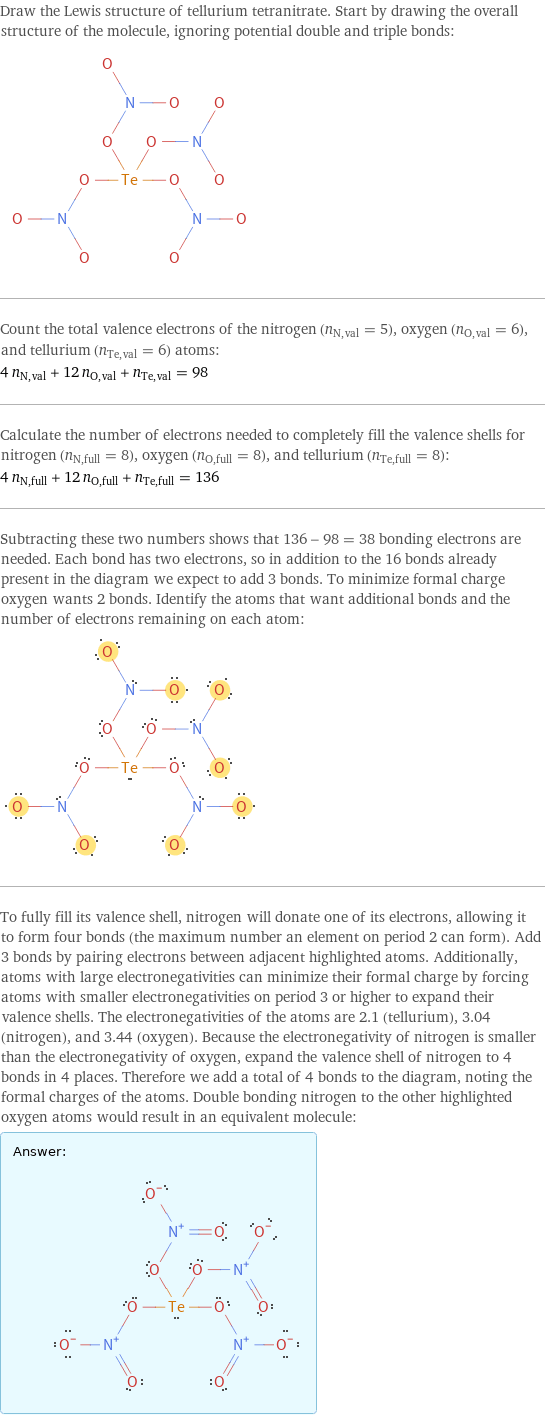Input interpretation

tellurium tetranitrate
Chemical names and formulas

formula | N_4O_12Te name | tellurium tetranitrate alternate names | tellurium(IV) nitrate | tellurium nitrate(1:4) mass fractions | N (nitrogen) 14.9% | O (oxygen) 51.1% | Te (tellurium) 34%
Lewis structure

Draw the Lewis structure of tellurium tetranitrate. Start by drawing the overall structure of the molecule, ignoring potential double and triple bonds: Count the total valence electrons of the nitrogen (n_N, val = 5), oxygen (n_O, val = 6), and tellurium (n_Te, val = 6) atoms: 4 n_N, val + 12 n_O, val + n_Te, val = 98 Calculate the number of electrons needed to completely fill the valence shells for nitrogen (n_N, full = 8), oxygen (n_O, full = 8), and tellurium (n_Te, full = 8): 4 n_N, full + 12 n_O, full + n_Te, full = 136 Subtracting these two numbers shows that 136 - 98 = 38 bonding electrons are needed. Each bond has two electrons, so in addition to the 16 bonds already present in the diagram we expect to add 3 bonds. To minimize formal charge oxygen wants 2 bonds. Identify the atoms that want additional bonds and the number of electrons remaining on each atom: To fully fill its valence shell, nitrogen will donate one of its electrons, allowing it to form four bonds (the maximum number an element on period 2 can form). Add 3 bonds by pairing electrons between adjacent highlighted atoms. Additionally, atoms with large electronegativities can minimize their formal charge by forcing atoms with smaller electronegativities on period 3 or higher to expand their valence shells. The electronegativities of the atoms are 2.1 (tellurium), 3.04 (nitrogen), and 3.44 (oxygen). Because the electronegativity of nitrogen is smaller than the electronegativity of oxygen, expand the valence shell of nitrogen to 4 bonds in 4 places. Therefore we add a total of 4 bonds to the diagram, noting the formal charges of the atoms. Double bonding nitrogen to the other highlighted oxygen atoms would result in an equivalent molecule: Answer: | |
Basic properties

molar mass | 375.62 g/mol
Units

Chemical identifiers
([O-])O[Te](O[N+](=O)[O-])(O[N+](=O)[O-])O[N+](=O)[O-] InChI identifier | InChI=1/N4O12Te/c5-1(6)13-17(14-2(7)8, 15-3(9)10)16-4(11)12 EU number | 244-629-0 Gmelin number | 605289](../image_source/6129b0520ca2a149d8f65553a93e5fd7.png)
CAS number | 21883-56-7 PubChem CID number | 89083 SMILES identifier | [N+](=O)([O-])O[Te](O[N+](=O)[O-])(O[N+](=O)[O-])O[N+](=O)[O-] InChI identifier | InChI=1/N4O12Te/c5-1(6)13-17(14-2(7)8, 15-3(9)10)16-4(11)12 EU number | 244-629-0 Gmelin number | 605289